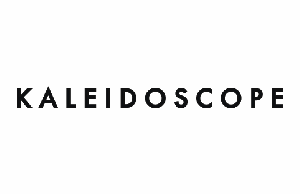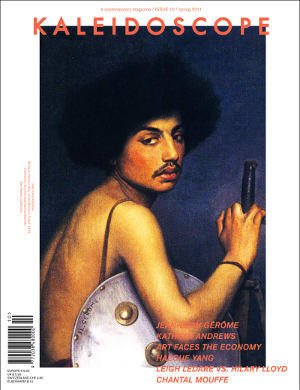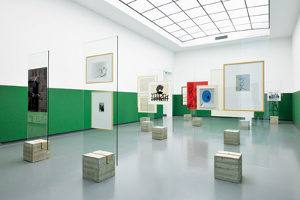L'edicola digitale delle riviste italiane di arte e cultura contemporanea
Kaleidoscope Anno 3 Numero 10 primavera 2011
Destroy the Museum
Charles Esche e Maria Lind

a contemporary magazine

HIGHLIGHTS: Michael E. Smith by Chris Sharp; Jean-Léon Gérome by Marie de Brugerolle; Kathryn Andrews interview by Michael Ned Holte; Criticism as Fiction? by Vincenzo Latronico; John Divola by Chris Wiley.
MAIN THEME: ART FACES THE ECONOMY: Superflex by Marina Vishmidt; Destroy the Museum Charles Esche and Maria Lind in conversation; Current Account by Nav Haq; Zachary Formwalt interview by Binna Choi.
MONO: HAEGUE YANG: The Whiteness of Meaning by Bart van der Heide; New Skin for the Old Ceremony by Joanna Fiduccia; Cittadella under Water, 2011 project by Haegue Yang; Material Agony interview by Yasmil Raymond.
COLUMNS: PIONEERS: Absalon by Simone Menegoi; FUTURA: Raumlabor interview by Hans Ulrich Obrist; MAPPING THE STUDIO: Heimo Zobernig by Luca Cerizza; VIA À VIS: Leigh Ledare and Hilary Lloyd interview by Elena Filipovic; CRITICAL SPACE: Chantal Mouffe by Markus Miessen; LAST QUESTION answer by Alessandro Pessoli
Torbjørn Rødland
Hanne Mugaas
n. 22 autunno -inverno 2014
John Armleder
Andrea Bellini
n. 21 estate 2014
Voiceover: Under the skin
Shama Khanna
n. 20 inverno 2013-2014
Yang Fudong
Davide Quadrio e Noah Cowan
n. 19 autunno 2013
Massimiliano Gioni
Francesco Manacorda
n. 18 estate 2013
John Currin
Catherine Wood
n. 17 inverno 2012-2013

interpreted by Wendelien van Oldenborgh, 2010
Installation view, Van Abbemuseum, Eindhoven, 2010
Photo: Peter Cox
The destruction of the existing model of the museum seems to be the only way to rebuild the symbolic capital of art. Through strategies of dispersion, extra-disciplinarity, and even funding cocktails, some institutions are beginning to chip away at their own foundations.
CE: I’d like to start with a distinction you have made between major and minor strands in art. What you call a major strand is more formally or materially “innovative” and “challenging,” while the minor strand is an analysis of existing conditions, a repetition or reenactment. The situation you describe was more than confirmed for me on a recent visit to Berlin, where I saw two exhibitions that seemed to illustrate the differences perfectly...
The first was a major, product-orientated contemporary art exhibition of the spectacle school, Carsten Höller’s installation in Hamburger Bahnhof. People could pay 1000 Euros to stay a night in the museum, receiving five-star attention and exclusive access to the public collection. The overnight “bedroom” was a high panoptical platform in the center of the room, accessible through an otherwise locked gate below the public grandstand, from which the ordinary visitor was invited to gawp at a motley array of animals caged in weak modernist designer pens. There is something almost pre-revolutionary in this shameless celebration of wealth on the part of both the artist, who was clearly given far too much money to produce something of value, and the institution, which is home to the Flick collection and other public-private initiatives but serves only private interest.
On view at the Haus der Kulturen der Welt was “The Potosí Principle,” in many ways a remarkable show, curated by artists and telling a story of early capitalism and primary exploitation in the Spanish colonies of South America. It used the production of art in Bolivia to portray what art shows us about the world and to chart connections between the baroque artistic languages of past and present.
What interests me about these exhibitions is the role of the curator. In Höller’s case, the curators facilitated his idea in order to attract publicity. In “The Potosí Principle,”the artists, as curators, refused the new in order to gain a critical distance from the works in the show and to make a bigger point about art’s relation to society. The latter seems the most interesting, but it also is firmly situated in the minor strand—and all the better for it.
Finally, I cannot avoid mentioning a superb curatorial project called Intolerance by Willem de Rooij at the Neue Nationalgalerie, which also privileged thinking over innovative product design.
ML: The idea of the “majors” and the “minors” was a simple exercise in trying to go beyond the dichotomies of mainstream and alternative, local and global, center and periphery, and even beyond the dialectics of local-global-glocal and center-periphery-relative periphery. Perhaps the majors and the minors can help us think about the current conditions for the production, presentation, distribution, and mediation of contemporary art that does not buy into base entertainment and spectacle, art that has a more complex agenda. The minor is a strand that runs parallel to the infotainment industry’s major strand, but which is in a different place in terms of influence and power. It is certainly less funded in monetary terms and yet, for brains and sensibility, it is the richer of the two. This is where “the new”—however ambiguous that term is—experiments and challenges the staus quo. In the art world, the majors and the minors are diverging more and more. Separation is the notion of the day: artists and other cultural producers start their own self-determined, continuous activities to avoid the effects of the dominant discourse. Rather than donate their collections and money to public institutions, as was the case in most of the Western world until fairly recently, collectors and wealthy donors found their own institutions.
We can now speak of the need for strategic separatism—a protective maneuver that creates space for important, and even pressing, considerations—while acknowledging that we are implicated in the system that is being questioned. If I want to place Carsten Höller’s exhibition on this map (I did not see “The Potosí Principle”), it is as an over-identification with a viral presence within the mainstream. His early work has an edge I always appreciated, whether we think of the small vicious toys or the beautiful performance/excursion in a park in Glasgow. Too much money has spoiled more than one oeuvre.
The minor strand seems to be engaged with the relatively closed production of new ideas, new protocols, choreographies, and orchestrations. I have no doubt that fascinating stuff will continue to come out of this: my concern is whether the minors will only be preaching to the converted and the majors running totally dry of content. How do you think about the symbolic capital generated by the minor strand? How can it best be used?
CE: In many ways I think we are using up the symbolic capital of the museum. The core audience still comes for what the museum represented in the past rather than what it does now, so at some point they will give up, I imagine, as will many modernist-trained critics. We are working hard on building different routes to a public, however, I think the art world by and large has failed to address new publics. For our museum, the Van Abbemuseum, I’m desperately trying to find ways out of this impasse, mostly by leaving the building, or at least dispersing the art across the city and perhaps the world. The art audience in general is probably one of the least interesting audiences for an art (or an institution) that seeks a different relationship with the world and its people. It is the audience least likely to be transformed by an artwork, because it already has a rather strict view of what art can do in the world. I was brought up in a leftist environment, in which we would spend afternoons walking the streets trying to sell newspapers, trying to persuade people of the significance of our political position, standing in the rain in Manchester trying to sell Socialist Organiser or whatever. It sounds a bit pathetic now, but the point is that it was really an attempt, however much it failed, to get ordinary working class people to understand the intellectual arguments we were putting forward. This kind of will has almost entirely been lost, not only at the level of art but of politics as well. Rarely is the effort made to persuade people with a radically different approach to consumer culture. Art could be the site for a different kind of action. Surely the still-remaining public field within art could draw a new kind of audience interested in a different aesthetics, ethics, and politics. It’s easier to rise to that challenge if you work consistently with a particular place and group of people, and that does mean that 365-day-a-year institutions are more suitable than biennials. That’s the symbolic capital I think we need to try to build, and we are only a small part of the way there.
ML: As the director of a museum whose general operation is becoming a model for how to do things differently, how do you relate to the commercial art market?
CE: The simple answer is that I try to relate as little as possible. I run a public institution that is not obliged to make a profit; we work with a limited number of artists, some of whom have galleries that demand their cut, which we give them if we want to buy a work. We turned against the art fairs, because they corrupt you, draw you in on the level of semi-high society, and spit you out as a conformist curator. I face a huge dilemma whenever we buy a work. Why buy? What is it about object possession that is so fundamental to the circulation of art especially with digital copying now? Yet I still buy because I feel I should leave a legacy to whoever comes after. (It is also to support the artist, though this could easily be achieved in other ways). Is this (egotistical) idea of leaving a legacy wrong? I am still seeking an answer, but I know that building an archive seems a more appropriate way to go. We have joined the museum archive and collection into one data bank of things, fact, and opinions, which has resulted in projects like the Living Archive, which represented the history of the museum to itself. This resulted in projects like the Living Archive, which represented the history of the museum to itself, or to parts of the Play Van Abbe program, which looked at the purchases after the Second World War for instance.
ML: I share some of your unease with possessions and property. Yet, I sometimes have to remind myself about the effect object-based artworks can have. The Swedish painting and sculpture I grew up seeing in the homes of my working-class grandparents and great grandmother had a tremendous effect on me.
But back to funding. In Institution Building: Artists, Curators, Architects in the Struggle for Institutional Space (ed. Nikolaus Hirsch et al), it is argued that a dynamic form of institution is the most productive one today—an institution that has a physical “anchor” that can function as a production center, but which at the same time is changeable and can encompass a growing cluster of buildings, is both nearby and far away, both temporary and permanent. This type of institution weaves together curating and architecture. I think there is a lot of potential in this model. My question is how you think about funding and dynamism. What happens if we transfer Hirsch’s institutional model to funding for contemporary art in general and art institutions in particular?
CE: The forms of the “avant-garde” have been taken up and reproduced in contemporary capitalist relations so precisely that dynamism just sounds like flexibility or innovation, which feeds the marketers and their paymasters.
I am interested in two ideas: one is the notion of a dispersed museum that would indeed reduce its centrifugal power to split and separate out into a city or even wider. The second is Brian Holmes’s concept of extra-disciplinarity, of setting up projects or investigations that function outside the academic and economic borders defining institutional behaviors. In that sense, I would agree that funding priorities should change. So, I guess I am for dynamism as long as it is not about endless production of new, temporary prototypes in order to see which will survive in the market, but rather about the destruction of an existing institution.
ML: I sympathize with the idea of a dispersed art museum. How do you generate funds for the museum, and how do you think about that, both theoretically and practically? I have come to believe more and more in funding cocktails, contrary to what I would have argued for 10 years ago, when public funding seemed preferable in terms of self-determination. Full funding from one source can faciliate “coups d’etat.” It is also important to point out that instrumentalization has galloped over the last decade and almost obliterated the previously respected arm’s-length principle. Private donors seem to generate different, and perhaps more severe, forms of self-censorship.
Another aspect of funding cocktails is somehow connected with what you call the failure to address new publics. In the future, we as curators and directors need to take mediation more seriously. There are ways to do this that don’t have to be overly didactic. Many emerging curators have limited interest in what art does in culture and society, how it can exist and be encountered and debated, beyond a narrow peer group.
At the same time, I believe that much is to be gained if, as Simon Sheikh has suggested, we focus on the co-production of public and semi-public space, rather than “reaching out to new publics.” The recent boom in the commercial market has its corollary in a turn toward bureaucracy. While the commercial market got its blows over the last couple of years, the cultural bureaucracy is still going strong, even increasing its influence.
CE: In terms of money, I am not sure there is such a thing as cleaner or dirtier money: there is just cash to be able to do things and it is what you do with it that counts. Paradoxically, I think it would be good if funding for the arts decreased in general. It would make absurdities, like the Carsten Höller nonsense, less likely and also bring the cost of more interesting artworks within range of more pockets. The fact that the richest private collectors can consistently outbid publicly-funded museums, which then have to beg for donations, is not a very desirable state. Though I am not against an art market as such, nor against money being exchanged for art, I do think it should have less significance and be challenged for its role as arbiter of taste and meaning by those minor forces we have talked about. It’s rather like my view of capitalism in general: it’s fine in smaller doses and under humane conditions. I would always support diversity and deviance, whether that’s in culture, politics, or the economy. I absolutely agree about mediation. That is what excited me about “The Potosí Principle.” Co-production of meaning, which would suggest a broader range of artistic forms and voices, is very desirable. I think both of these developments can best emerge when an art institution takes up a clear position and asks those who are interested to get involved. At that point, the control of the program has to leave the curatorial offices and be shared with people outside of it.
CHARLES ESCHE(b. 1962) is a British curator and writer. Since 2004, he has been Director of the Van Abbemuseum, Eindhoven, Netherlands. He is cofounder and co-editor of Afterall Journaland Afterall Books with Mark Lewis. In 2005 he was co-curator of the 9th International Istanbul Biennial with Vasif Kortun and in 2002 the co-curator with Hou Hanru and Song Wan Kyung of the Gwangju Biennale.
MARIA LIND is the newly-appointed Director of Tensta Konsthall. From 2008 to 2010, she was director of the Masters Program at the Center for Curatorial Studies at Bard College in New York. She was head of Iaspis in Stockholm in 2005-2007 and head of Kunstverein Munchen in 2002-2004. From 1997 to 2001 she was a curator at Modern Museet and in 1998 a co-curator of Manifesta 2, Europe’s art biennale.


